Leadership and Management Report: Sainsbury's, Operations
VerifiedAdded on 2023/01/06
|14
|3978
|64
Report
AI Summary
This report provides a comprehensive analysis of leadership and management principles within the context of Sainsbury's, a major supermarket chain. It begins by defining and comparing the roles and characteristics of leaders and managers, highlighting their distinct responsibilities and attributes. The report then examines how these roles apply in various situational contexts, such as new product launches and conflict management, illustrating the practical application of leadership and management in real-world scenarios. Furthermore, it delves into the application of different leadership theories and models, including situational leadership, systems leadership, and contingency leadership, to demonstrate their relevance in operational management. The report also explores key approaches to operations management, emphasizing the roles of leaders and managers in achieving business objectives. Finally, it assesses the factors within the business environment that impact operational management and decision-making by leaders and managers, providing a holistic view of leadership and management challenges and opportunities within the organization.

Paraphrase This Document
Need a fresh take? Get an instant paraphrase of this document with our AI Paraphraser
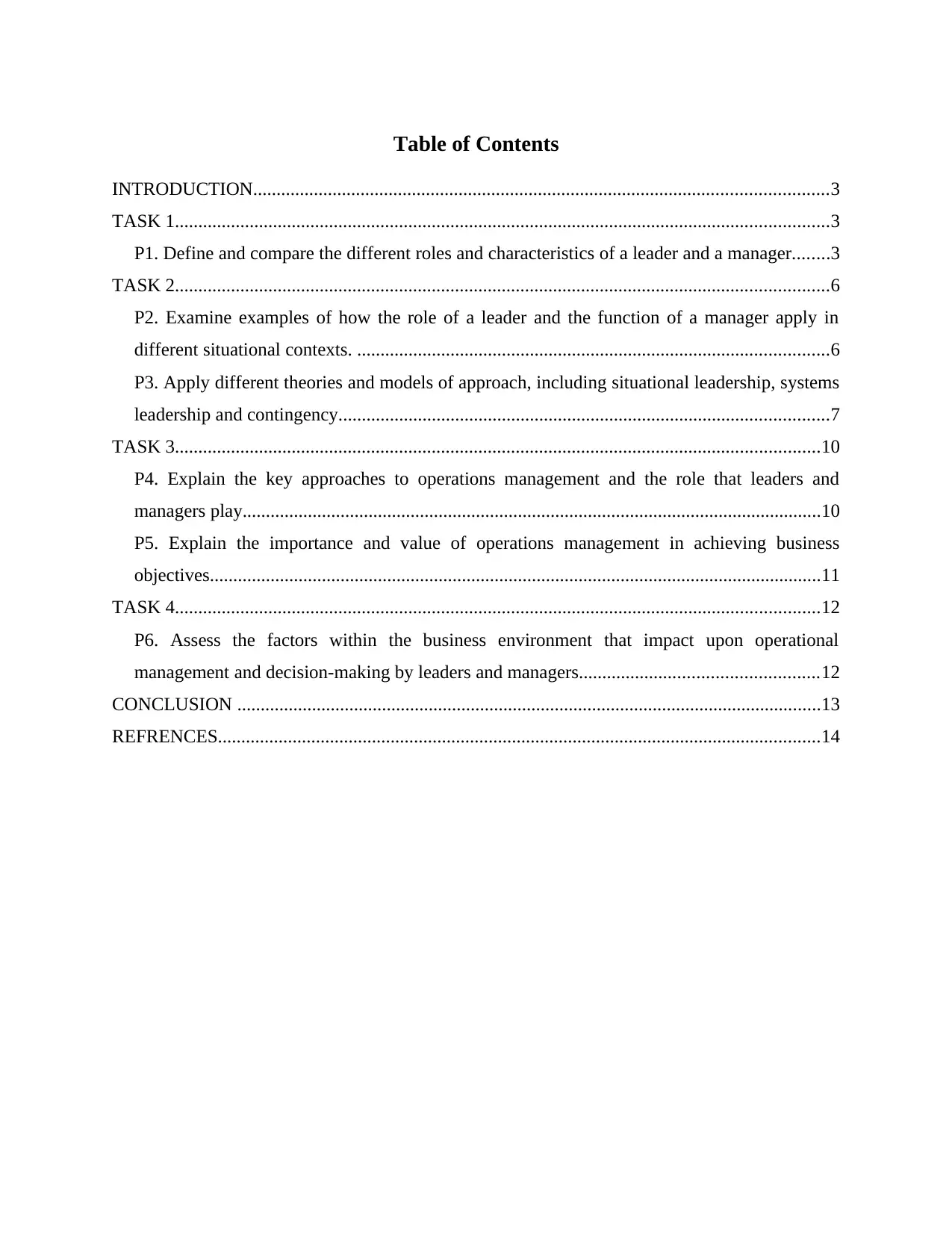
Table of Contents
INTRODUCTION...........................................................................................................................3
TASK 1............................................................................................................................................3
P1. Define and compare the different roles and characteristics of a leader and a manager........3
TASK 2............................................................................................................................................6
P2. Examine examples of how the role of a leader and the function of a manager apply in
different situational contexts. .....................................................................................................6
P3. Apply different theories and models of approach, including situational leadership, systems
leadership and contingency.........................................................................................................7
TASK 3..........................................................................................................................................10
P4. Explain the key approaches to operations management and the role that leaders and
managers play............................................................................................................................10
P5. Explain the importance and value of operations management in achieving business
objectives...................................................................................................................................11
TASK 4..........................................................................................................................................12
P6. Assess the factors within the business environment that impact upon operational
management and decision-making by leaders and managers...................................................12
CONCLUSION .............................................................................................................................13
REFRENCES.................................................................................................................................14
INTRODUCTION...........................................................................................................................3
TASK 1............................................................................................................................................3
P1. Define and compare the different roles and characteristics of a leader and a manager........3
TASK 2............................................................................................................................................6
P2. Examine examples of how the role of a leader and the function of a manager apply in
different situational contexts. .....................................................................................................6
P3. Apply different theories and models of approach, including situational leadership, systems
leadership and contingency.........................................................................................................7
TASK 3..........................................................................................................................................10
P4. Explain the key approaches to operations management and the role that leaders and
managers play............................................................................................................................10
P5. Explain the importance and value of operations management in achieving business
objectives...................................................................................................................................11
TASK 4..........................................................................................................................................12
P6. Assess the factors within the business environment that impact upon operational
management and decision-making by leaders and managers...................................................12
CONCLUSION .............................................................................................................................13
REFRENCES.................................................................................................................................14
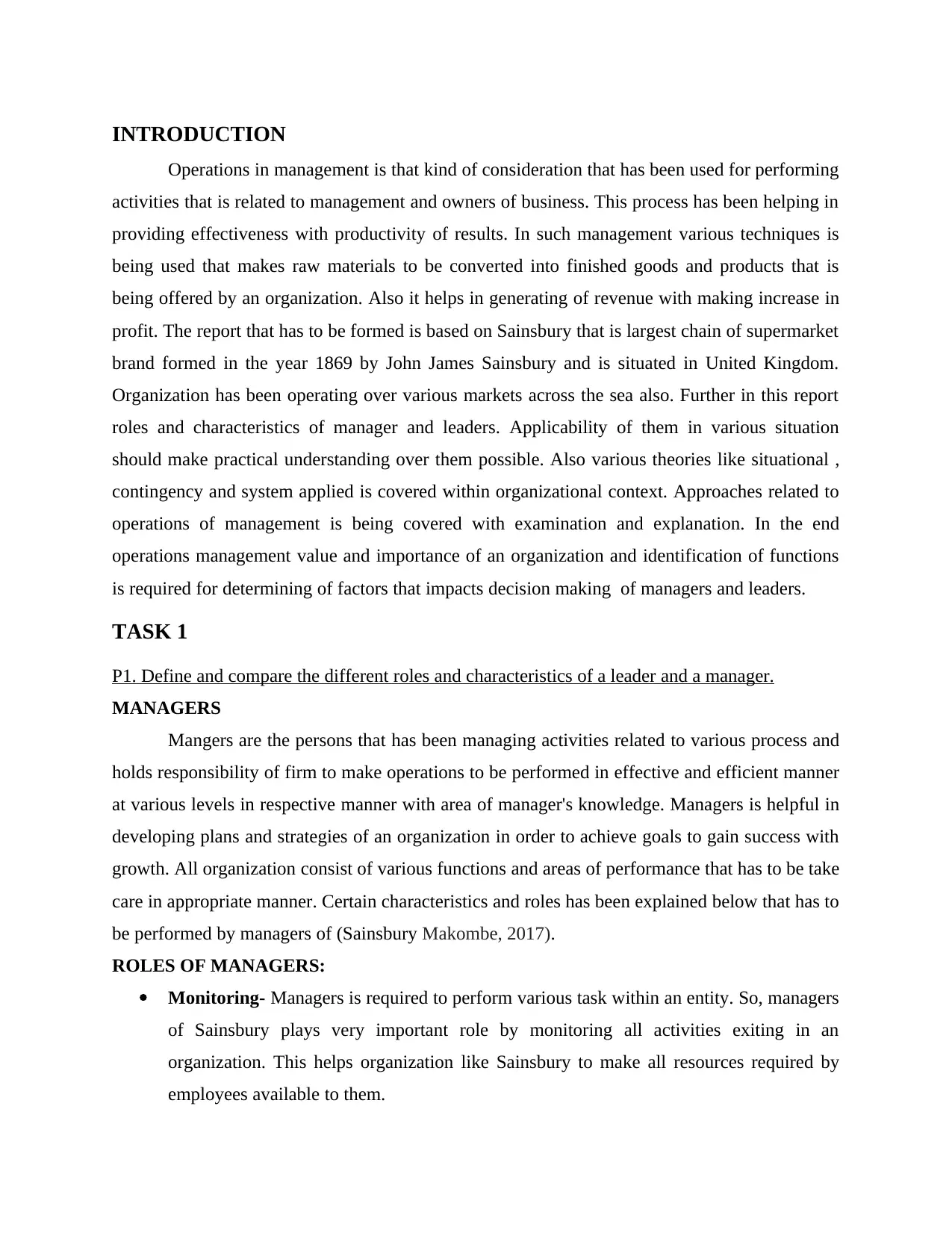
INTRODUCTION
Operations in management is that kind of consideration that has been used for performing
activities that is related to management and owners of business. This process has been helping in
providing effectiveness with productivity of results. In such management various techniques is
being used that makes raw materials to be converted into finished goods and products that is
being offered by an organization. Also it helps in generating of revenue with making increase in
profit. The report that has to be formed is based on Sainsbury that is largest chain of supermarket
brand formed in the year 1869 by John James Sainsbury and is situated in United Kingdom.
Organization has been operating over various markets across the sea also. Further in this report
roles and characteristics of manager and leaders. Applicability of them in various situation
should make practical understanding over them possible. Also various theories like situational ,
contingency and system applied is covered within organizational context. Approaches related to
operations of management is being covered with examination and explanation. In the end
operations management value and importance of an organization and identification of functions
is required for determining of factors that impacts decision making of managers and leaders.
TASK 1
P1. Define and compare the different roles and characteristics of a leader and a manager.
MANAGERS
Mangers are the persons that has been managing activities related to various process and
holds responsibility of firm to make operations to be performed in effective and efficient manner
at various levels in respective manner with area of manager's knowledge. Managers is helpful in
developing plans and strategies of an organization in order to achieve goals to gain success with
growth. All organization consist of various functions and areas of performance that has to be take
care in appropriate manner. Certain characteristics and roles has been explained below that has to
be performed by managers of (Sainsbury Makombe, 2017).
ROLES OF MANAGERS:
Monitoring- Managers is required to perform various task within an entity. So, managers
of Sainsbury plays very important role by monitoring all activities exiting in an
organization. This helps organization like Sainsbury to make all resources required by
employees available to them.
Operations in management is that kind of consideration that has been used for performing
activities that is related to management and owners of business. This process has been helping in
providing effectiveness with productivity of results. In such management various techniques is
being used that makes raw materials to be converted into finished goods and products that is
being offered by an organization. Also it helps in generating of revenue with making increase in
profit. The report that has to be formed is based on Sainsbury that is largest chain of supermarket
brand formed in the year 1869 by John James Sainsbury and is situated in United Kingdom.
Organization has been operating over various markets across the sea also. Further in this report
roles and characteristics of manager and leaders. Applicability of them in various situation
should make practical understanding over them possible. Also various theories like situational ,
contingency and system applied is covered within organizational context. Approaches related to
operations of management is being covered with examination and explanation. In the end
operations management value and importance of an organization and identification of functions
is required for determining of factors that impacts decision making of managers and leaders.
TASK 1
P1. Define and compare the different roles and characteristics of a leader and a manager.
MANAGERS
Mangers are the persons that has been managing activities related to various process and
holds responsibility of firm to make operations to be performed in effective and efficient manner
at various levels in respective manner with area of manager's knowledge. Managers is helpful in
developing plans and strategies of an organization in order to achieve goals to gain success with
growth. All organization consist of various functions and areas of performance that has to be take
care in appropriate manner. Certain characteristics and roles has been explained below that has to
be performed by managers of (Sainsbury Makombe, 2017).
ROLES OF MANAGERS:
Monitoring- Managers is required to perform various task within an entity. So, managers
of Sainsbury plays very important role by monitoring all activities exiting in an
organization. This helps organization like Sainsbury to make all resources required by
employees available to them.
⊘ This is a preview!⊘
Do you want full access?
Subscribe today to unlock all pages.

Trusted by 1+ million students worldwide
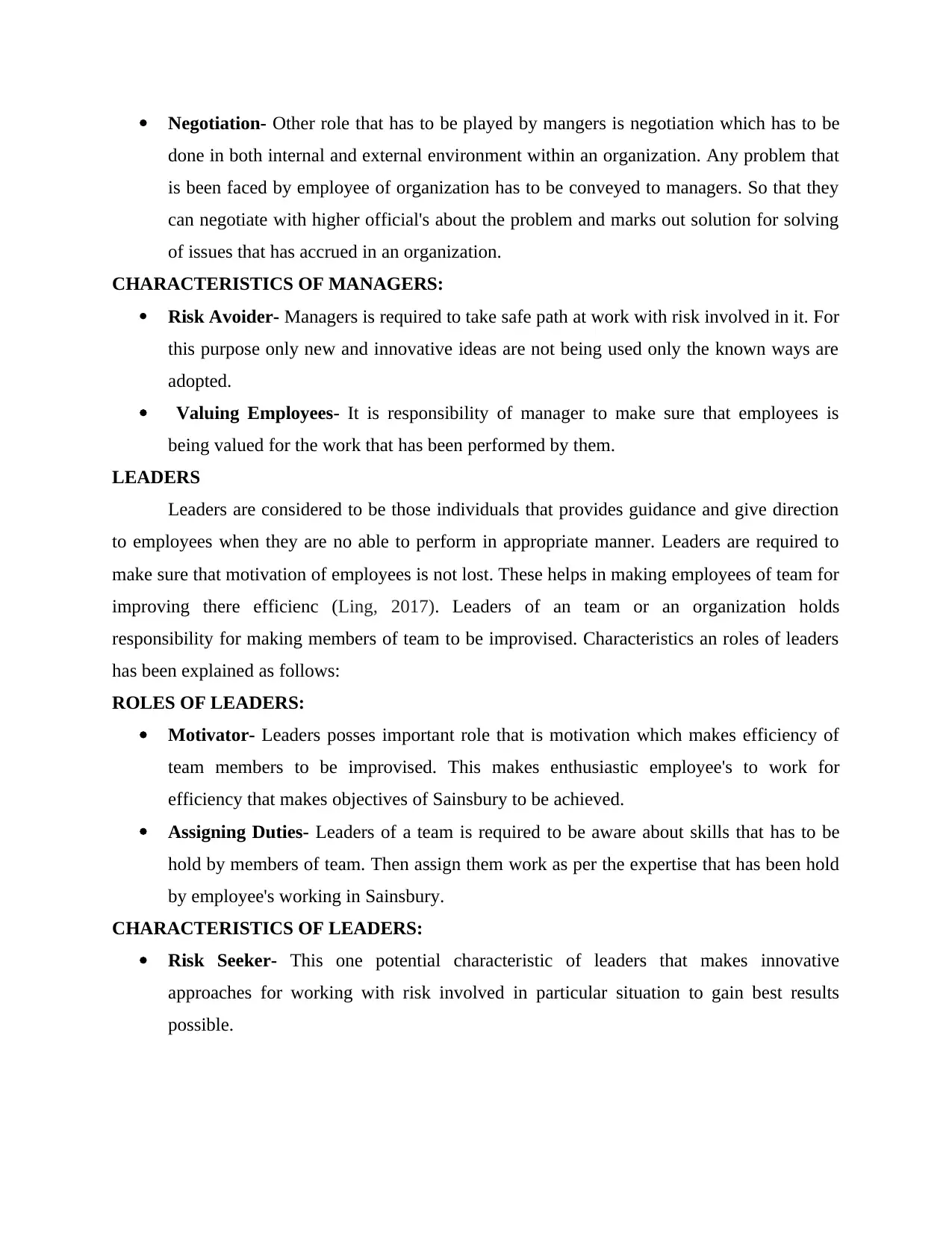
Negotiation- Other role that has to be played by mangers is negotiation which has to be
done in both internal and external environment within an organization. Any problem that
is been faced by employee of organization has to be conveyed to managers. So that they
can negotiate with higher official's about the problem and marks out solution for solving
of issues that has accrued in an organization.
CHARACTERISTICS OF MANAGERS:
Risk Avoider- Managers is required to take safe path at work with risk involved in it. For
this purpose only new and innovative ideas are not being used only the known ways are
adopted.
Valuing Employees- It is responsibility of manager to make sure that employees is
being valued for the work that has been performed by them.
LEADERS
Leaders are considered to be those individuals that provides guidance and give direction
to employees when they are no able to perform in appropriate manner. Leaders are required to
make sure that motivation of employees is not lost. These helps in making employees of team for
improving there efficienc (Ling, 2017). Leaders of an team or an organization holds
responsibility for making members of team to be improvised. Characteristics an roles of leaders
has been explained as follows:
ROLES OF LEADERS:
Motivator- Leaders posses important role that is motivation which makes efficiency of
team members to be improvised. This makes enthusiastic employee's to work for
efficiency that makes objectives of Sainsbury to be achieved.
Assigning Duties- Leaders of a team is required to be aware about skills that has to be
hold by members of team. Then assign them work as per the expertise that has been hold
by employee's working in Sainsbury.
CHARACTERISTICS OF LEADERS:
Risk Seeker- This one potential characteristic of leaders that makes innovative
approaches for working with risk involved in particular situation to gain best results
possible.
done in both internal and external environment within an organization. Any problem that
is been faced by employee of organization has to be conveyed to managers. So that they
can negotiate with higher official's about the problem and marks out solution for solving
of issues that has accrued in an organization.
CHARACTERISTICS OF MANAGERS:
Risk Avoider- Managers is required to take safe path at work with risk involved in it. For
this purpose only new and innovative ideas are not being used only the known ways are
adopted.
Valuing Employees- It is responsibility of manager to make sure that employees is
being valued for the work that has been performed by them.
LEADERS
Leaders are considered to be those individuals that provides guidance and give direction
to employees when they are no able to perform in appropriate manner. Leaders are required to
make sure that motivation of employees is not lost. These helps in making employees of team for
improving there efficienc (Ling, 2017). Leaders of an team or an organization holds
responsibility for making members of team to be improvised. Characteristics an roles of leaders
has been explained as follows:
ROLES OF LEADERS:
Motivator- Leaders posses important role that is motivation which makes efficiency of
team members to be improvised. This makes enthusiastic employee's to work for
efficiency that makes objectives of Sainsbury to be achieved.
Assigning Duties- Leaders of a team is required to be aware about skills that has to be
hold by members of team. Then assign them work as per the expertise that has been hold
by employee's working in Sainsbury.
CHARACTERISTICS OF LEADERS:
Risk Seeker- This one potential characteristic of leaders that makes innovative
approaches for working with risk involved in particular situation to gain best results
possible.
Paraphrase This Document
Need a fresh take? Get an instant paraphrase of this document with our AI Paraphraser
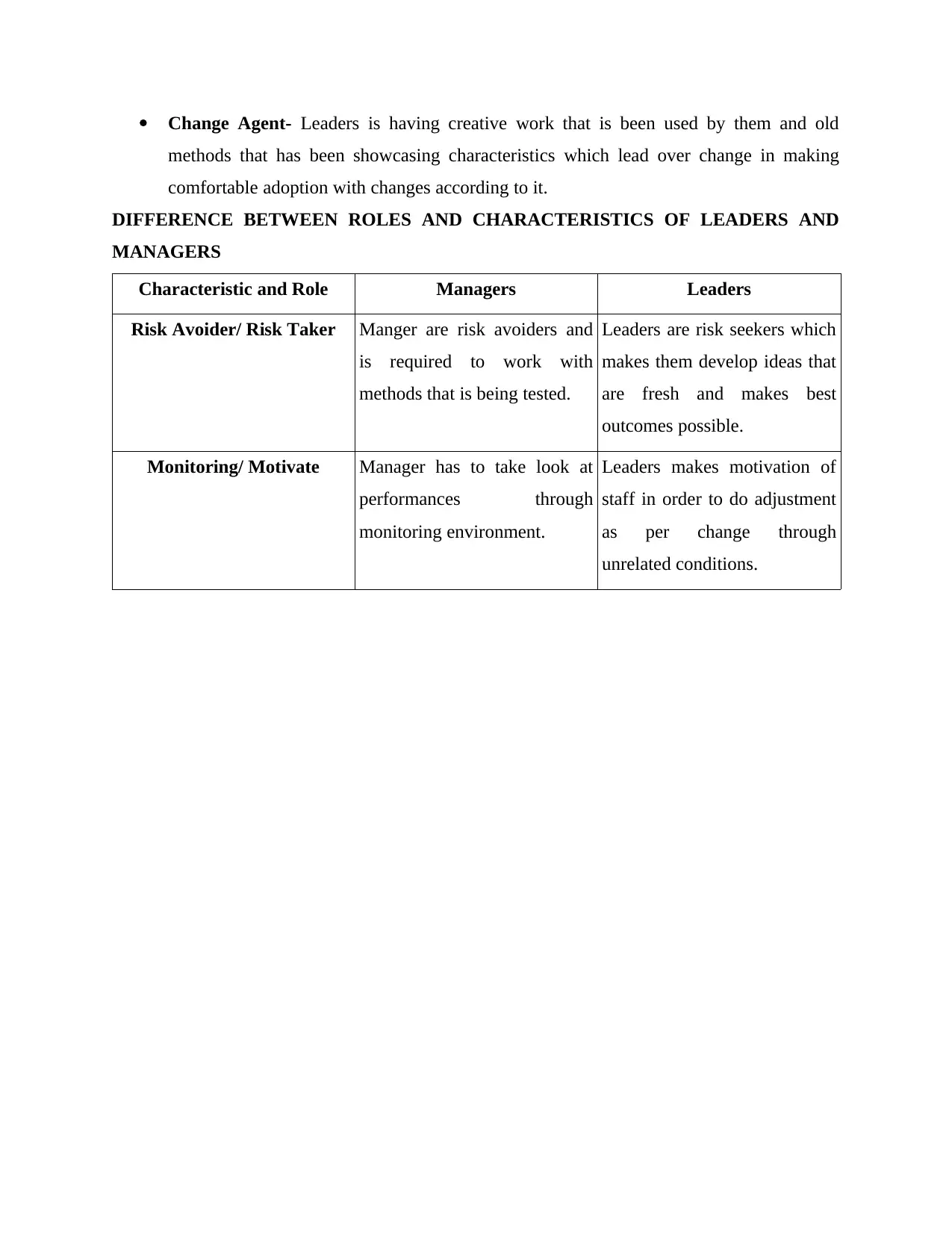
Change Agent- Leaders is having creative work that is been used by them and old
methods that has been showcasing characteristics which lead over change in making
comfortable adoption with changes according to it.
DIFFERENCE BETWEEN ROLES AND CHARACTERISTICS OF LEADERS AND
MANAGERS
Characteristic and Role Managers Leaders
Risk Avoider/ Risk Taker Manger are risk avoiders and
is required to work with
methods that is being tested.
Leaders are risk seekers which
makes them develop ideas that
are fresh and makes best
outcomes possible.
Monitoring/ Motivate Manager has to take look at
performances through
monitoring environment.
Leaders makes motivation of
staff in order to do adjustment
as per change through
unrelated conditions.
methods that has been showcasing characteristics which lead over change in making
comfortable adoption with changes according to it.
DIFFERENCE BETWEEN ROLES AND CHARACTERISTICS OF LEADERS AND
MANAGERS
Characteristic and Role Managers Leaders
Risk Avoider/ Risk Taker Manger are risk avoiders and
is required to work with
methods that is being tested.
Leaders are risk seekers which
makes them develop ideas that
are fresh and makes best
outcomes possible.
Monitoring/ Motivate Manager has to take look at
performances through
monitoring environment.
Leaders makes motivation of
staff in order to do adjustment
as per change through
unrelated conditions.
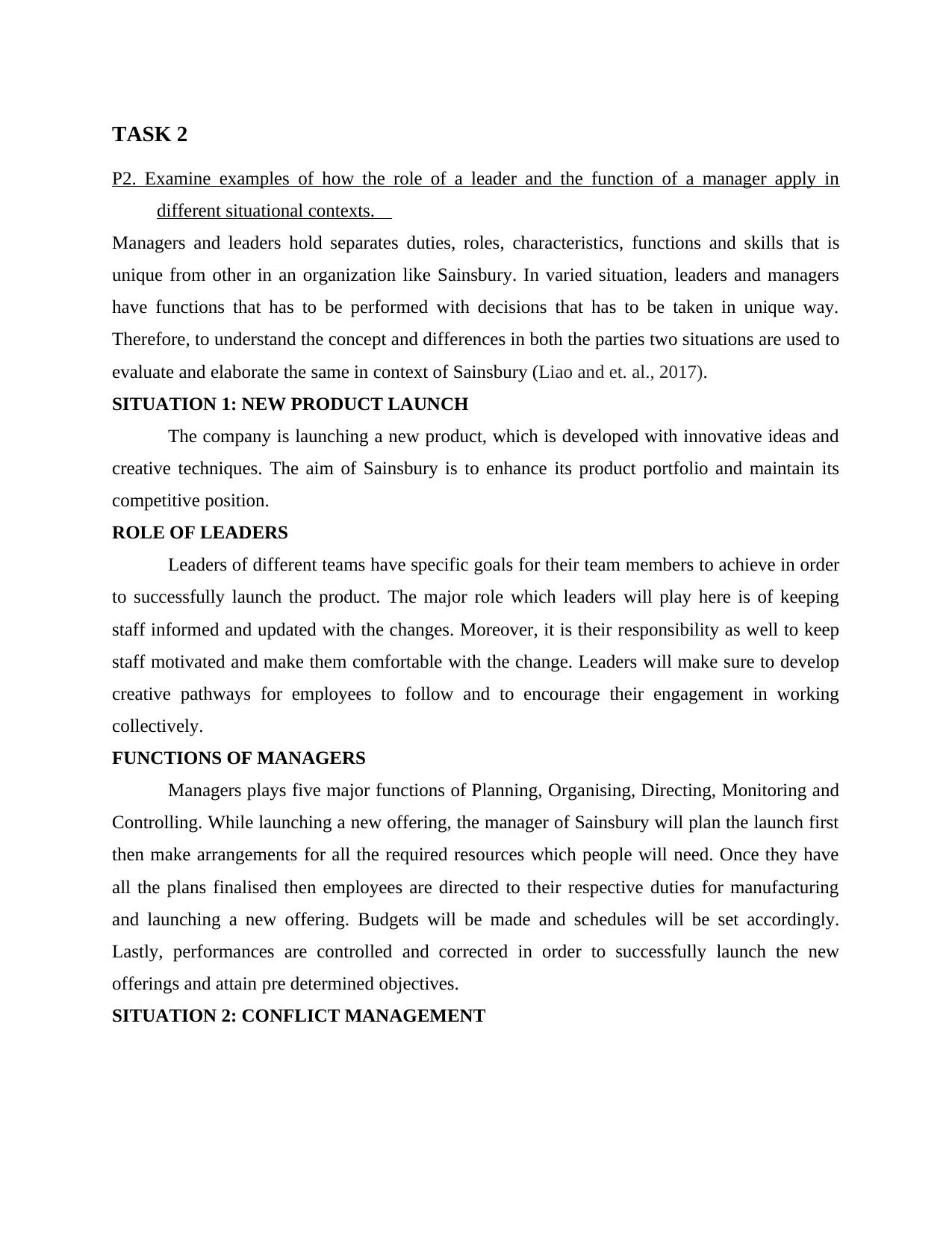
TASK 2
P2. Examine examples of how the role of a leader and the function of a manager apply in
different situational contexts.
Managers and leaders hold separates duties, roles, characteristics, functions and skills that is
unique from other in an organization like Sainsbury. In varied situation, leaders and managers
have functions that has to be performed with decisions that has to be taken in unique way.
Therefore, to understand the concept and differences in both the parties two situations are used to
evaluate and elaborate the same in context of Sainsbury (Liao and et. al., 2017).
SITUATION 1: NEW PRODUCT LAUNCH
The company is launching a new product, which is developed with innovative ideas and
creative techniques. The aim of Sainsbury is to enhance its product portfolio and maintain its
competitive position.
ROLE OF LEADERS
Leaders of different teams have specific goals for their team members to achieve in order
to successfully launch the product. The major role which leaders will play here is of keeping
staff informed and updated with the changes. Moreover, it is their responsibility as well to keep
staff motivated and make them comfortable with the change. Leaders will make sure to develop
creative pathways for employees to follow and to encourage their engagement in working
collectively.
FUNCTIONS OF MANAGERS
Managers plays five major functions of Planning, Organising, Directing, Monitoring and
Controlling. While launching a new offering, the manager of Sainsbury will plan the launch first
then make arrangements for all the required resources which people will need. Once they have
all the plans finalised then employees are directed to their respective duties for manufacturing
and launching a new offering. Budgets will be made and schedules will be set accordingly.
Lastly, performances are controlled and corrected in order to successfully launch the new
offerings and attain pre determined objectives.
SITUATION 2: CONFLICT MANAGEMENT
P2. Examine examples of how the role of a leader and the function of a manager apply in
different situational contexts.
Managers and leaders hold separates duties, roles, characteristics, functions and skills that is
unique from other in an organization like Sainsbury. In varied situation, leaders and managers
have functions that has to be performed with decisions that has to be taken in unique way.
Therefore, to understand the concept and differences in both the parties two situations are used to
evaluate and elaborate the same in context of Sainsbury (Liao and et. al., 2017).
SITUATION 1: NEW PRODUCT LAUNCH
The company is launching a new product, which is developed with innovative ideas and
creative techniques. The aim of Sainsbury is to enhance its product portfolio and maintain its
competitive position.
ROLE OF LEADERS
Leaders of different teams have specific goals for their team members to achieve in order
to successfully launch the product. The major role which leaders will play here is of keeping
staff informed and updated with the changes. Moreover, it is their responsibility as well to keep
staff motivated and make them comfortable with the change. Leaders will make sure to develop
creative pathways for employees to follow and to encourage their engagement in working
collectively.
FUNCTIONS OF MANAGERS
Managers plays five major functions of Planning, Organising, Directing, Monitoring and
Controlling. While launching a new offering, the manager of Sainsbury will plan the launch first
then make arrangements for all the required resources which people will need. Once they have
all the plans finalised then employees are directed to their respective duties for manufacturing
and launching a new offering. Budgets will be made and schedules will be set accordingly.
Lastly, performances are controlled and corrected in order to successfully launch the new
offerings and attain pre determined objectives.
SITUATION 2: CONFLICT MANAGEMENT
⊘ This is a preview!⊘
Do you want full access?
Subscribe today to unlock all pages.

Trusted by 1+ million students worldwide
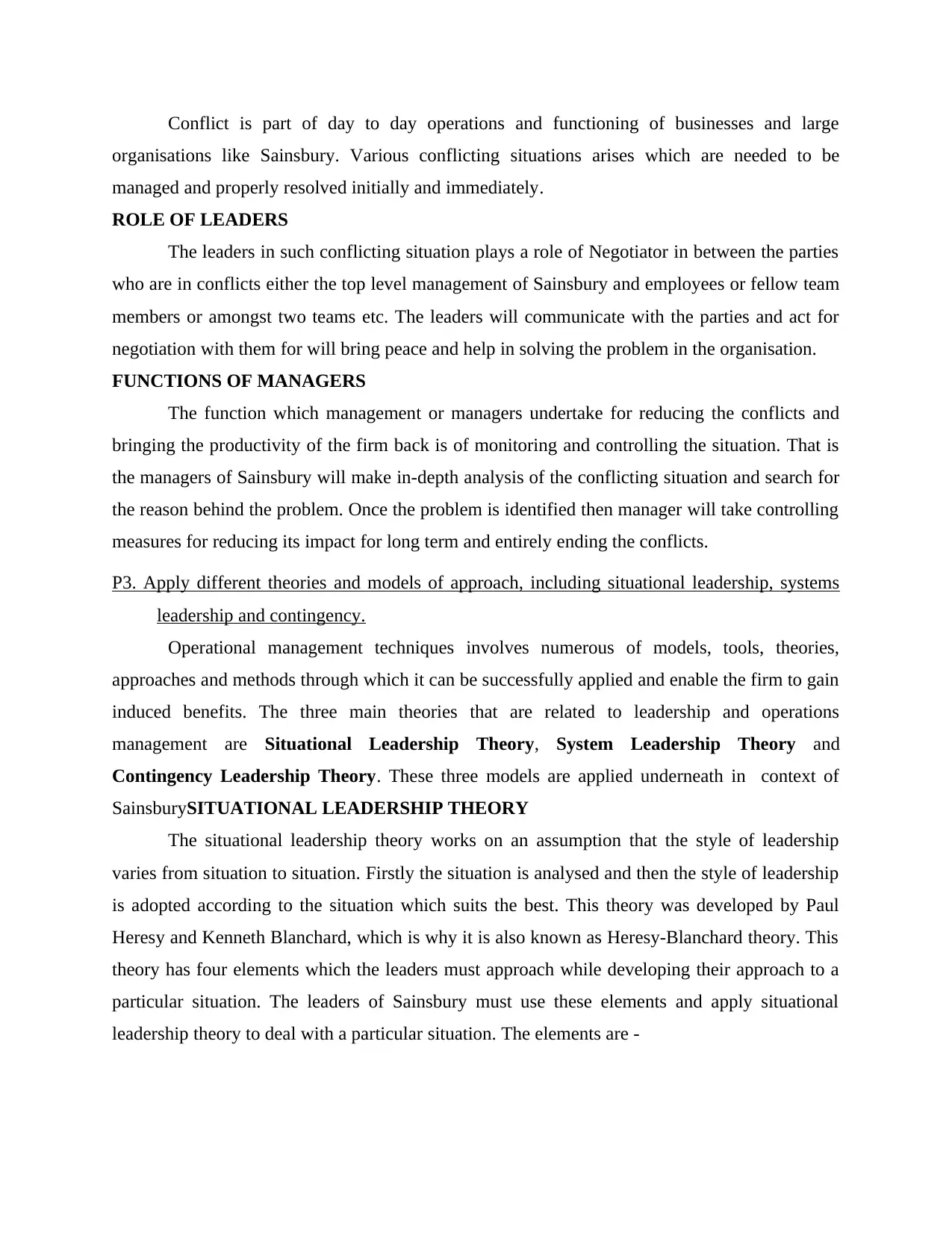
Conflict is part of day to day operations and functioning of businesses and large
organisations like Sainsbury. Various conflicting situations arises which are needed to be
managed and properly resolved initially and immediately.
ROLE OF LEADERS
The leaders in such conflicting situation plays a role of Negotiator in between the parties
who are in conflicts either the top level management of Sainsbury and employees or fellow team
members or amongst two teams etc. The leaders will communicate with the parties and act for
negotiation with them for will bring peace and help in solving the problem in the organisation.
FUNCTIONS OF MANAGERS
The function which management or managers undertake for reducing the conflicts and
bringing the productivity of the firm back is of monitoring and controlling the situation. That is
the managers of Sainsbury will make in-depth analysis of the conflicting situation and search for
the reason behind the problem. Once the problem is identified then manager will take controlling
measures for reducing its impact for long term and entirely ending the conflicts.
P3. Apply different theories and models of approach, including situational leadership, systems
leadership and contingency.
Operational management techniques involves numerous of models, tools, theories,
approaches and methods through which it can be successfully applied and enable the firm to gain
induced benefits. The three main theories that are related to leadership and operations
management are Situational Leadership Theory, System Leadership Theory and
Contingency Leadership Theory. These three models are applied underneath in context of
SainsburySITUATIONAL LEADERSHIP THEORY
The situational leadership theory works on an assumption that the style of leadership
varies from situation to situation. Firstly the situation is analysed and then the style of leadership
is adopted according to the situation which suits the best. This theory was developed by Paul
Heresy and Kenneth Blanchard, which is why it is also known as Heresy-Blanchard theory. This
theory has four elements which the leaders must approach while developing their approach to a
particular situation. The leaders of Sainsbury must use these elements and apply situational
leadership theory to deal with a particular situation. The elements are -
organisations like Sainsbury. Various conflicting situations arises which are needed to be
managed and properly resolved initially and immediately.
ROLE OF LEADERS
The leaders in such conflicting situation plays a role of Negotiator in between the parties
who are in conflicts either the top level management of Sainsbury and employees or fellow team
members or amongst two teams etc. The leaders will communicate with the parties and act for
negotiation with them for will bring peace and help in solving the problem in the organisation.
FUNCTIONS OF MANAGERS
The function which management or managers undertake for reducing the conflicts and
bringing the productivity of the firm back is of monitoring and controlling the situation. That is
the managers of Sainsbury will make in-depth analysis of the conflicting situation and search for
the reason behind the problem. Once the problem is identified then manager will take controlling
measures for reducing its impact for long term and entirely ending the conflicts.
P3. Apply different theories and models of approach, including situational leadership, systems
leadership and contingency.
Operational management techniques involves numerous of models, tools, theories,
approaches and methods through which it can be successfully applied and enable the firm to gain
induced benefits. The three main theories that are related to leadership and operations
management are Situational Leadership Theory, System Leadership Theory and
Contingency Leadership Theory. These three models are applied underneath in context of
SainsburySITUATIONAL LEADERSHIP THEORY
The situational leadership theory works on an assumption that the style of leadership
varies from situation to situation. Firstly the situation is analysed and then the style of leadership
is adopted according to the situation which suits the best. This theory was developed by Paul
Heresy and Kenneth Blanchard, which is why it is also known as Heresy-Blanchard theory. This
theory has four elements which the leaders must approach while developing their approach to a
particular situation. The leaders of Sainsbury must use these elements and apply situational
leadership theory to deal with a particular situation. The elements are -
Paraphrase This Document
Need a fresh take? Get an instant paraphrase of this document with our AI Paraphraser
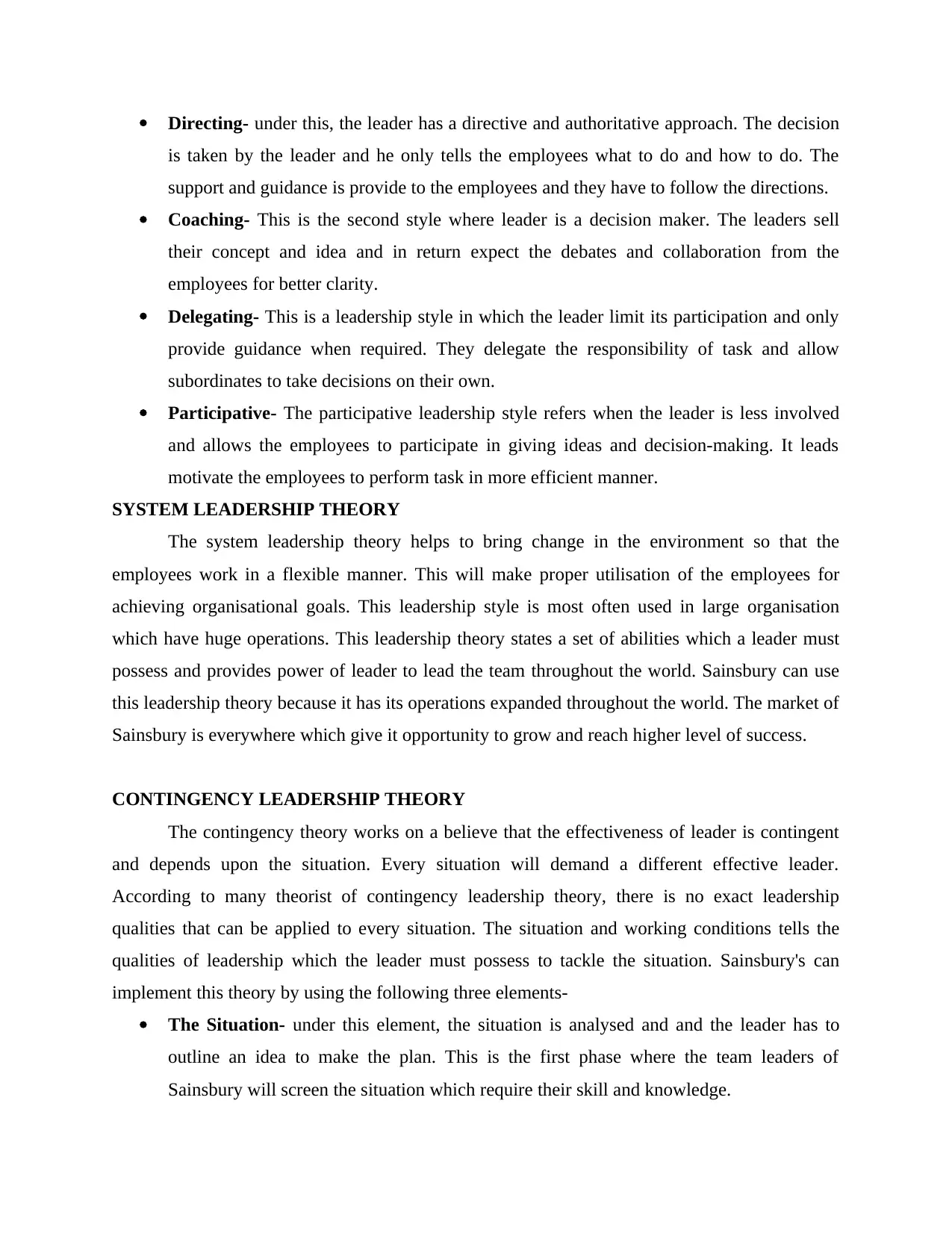
Directing- under this, the leader has a directive and authoritative approach. The decision
is taken by the leader and he only tells the employees what to do and how to do. The
support and guidance is provide to the employees and they have to follow the directions.
Coaching- This is the second style where leader is a decision maker. The leaders sell
their concept and idea and in return expect the debates and collaboration from the
employees for better clarity.
Delegating- This is a leadership style in which the leader limit its participation and only
provide guidance when required. They delegate the responsibility of task and allow
subordinates to take decisions on their own.
Participative- The participative leadership style refers when the leader is less involved
and allows the employees to participate in giving ideas and decision-making. It leads
motivate the employees to perform task in more efficient manner.
SYSTEM LEADERSHIP THEORY
The system leadership theory helps to bring change in the environment so that the
employees work in a flexible manner. This will make proper utilisation of the employees for
achieving organisational goals. This leadership style is most often used in large organisation
which have huge operations. This leadership theory states a set of abilities which a leader must
possess and provides power of leader to lead the team throughout the world. Sainsbury can use
this leadership theory because it has its operations expanded throughout the world. The market of
Sainsbury is everywhere which give it opportunity to grow and reach higher level of success.
CONTINGENCY LEADERSHIP THEORY
The contingency theory works on a believe that the effectiveness of leader is contingent
and depends upon the situation. Every situation will demand a different effective leader.
According to many theorist of contingency leadership theory, there is no exact leadership
qualities that can be applied to every situation. The situation and working conditions tells the
qualities of leadership which the leader must possess to tackle the situation. Sainsbury's can
implement this theory by using the following three elements-
The Situation- under this element, the situation is analysed and and the leader has to
outline an idea to make the plan. This is the first phase where the team leaders of
Sainsbury will screen the situation which require their skill and knowledge.
is taken by the leader and he only tells the employees what to do and how to do. The
support and guidance is provide to the employees and they have to follow the directions.
Coaching- This is the second style where leader is a decision maker. The leaders sell
their concept and idea and in return expect the debates and collaboration from the
employees for better clarity.
Delegating- This is a leadership style in which the leader limit its participation and only
provide guidance when required. They delegate the responsibility of task and allow
subordinates to take decisions on their own.
Participative- The participative leadership style refers when the leader is less involved
and allows the employees to participate in giving ideas and decision-making. It leads
motivate the employees to perform task in more efficient manner.
SYSTEM LEADERSHIP THEORY
The system leadership theory helps to bring change in the environment so that the
employees work in a flexible manner. This will make proper utilisation of the employees for
achieving organisational goals. This leadership style is most often used in large organisation
which have huge operations. This leadership theory states a set of abilities which a leader must
possess and provides power of leader to lead the team throughout the world. Sainsbury can use
this leadership theory because it has its operations expanded throughout the world. The market of
Sainsbury is everywhere which give it opportunity to grow and reach higher level of success.
CONTINGENCY LEADERSHIP THEORY
The contingency theory works on a believe that the effectiveness of leader is contingent
and depends upon the situation. Every situation will demand a different effective leader.
According to many theorist of contingency leadership theory, there is no exact leadership
qualities that can be applied to every situation. The situation and working conditions tells the
qualities of leadership which the leader must possess to tackle the situation. Sainsbury's can
implement this theory by using the following three elements-
The Situation- under this element, the situation is analysed and and the leader has to
outline an idea to make the plan. This is the first phase where the team leaders of
Sainsbury will screen the situation which require their skill and knowledge.
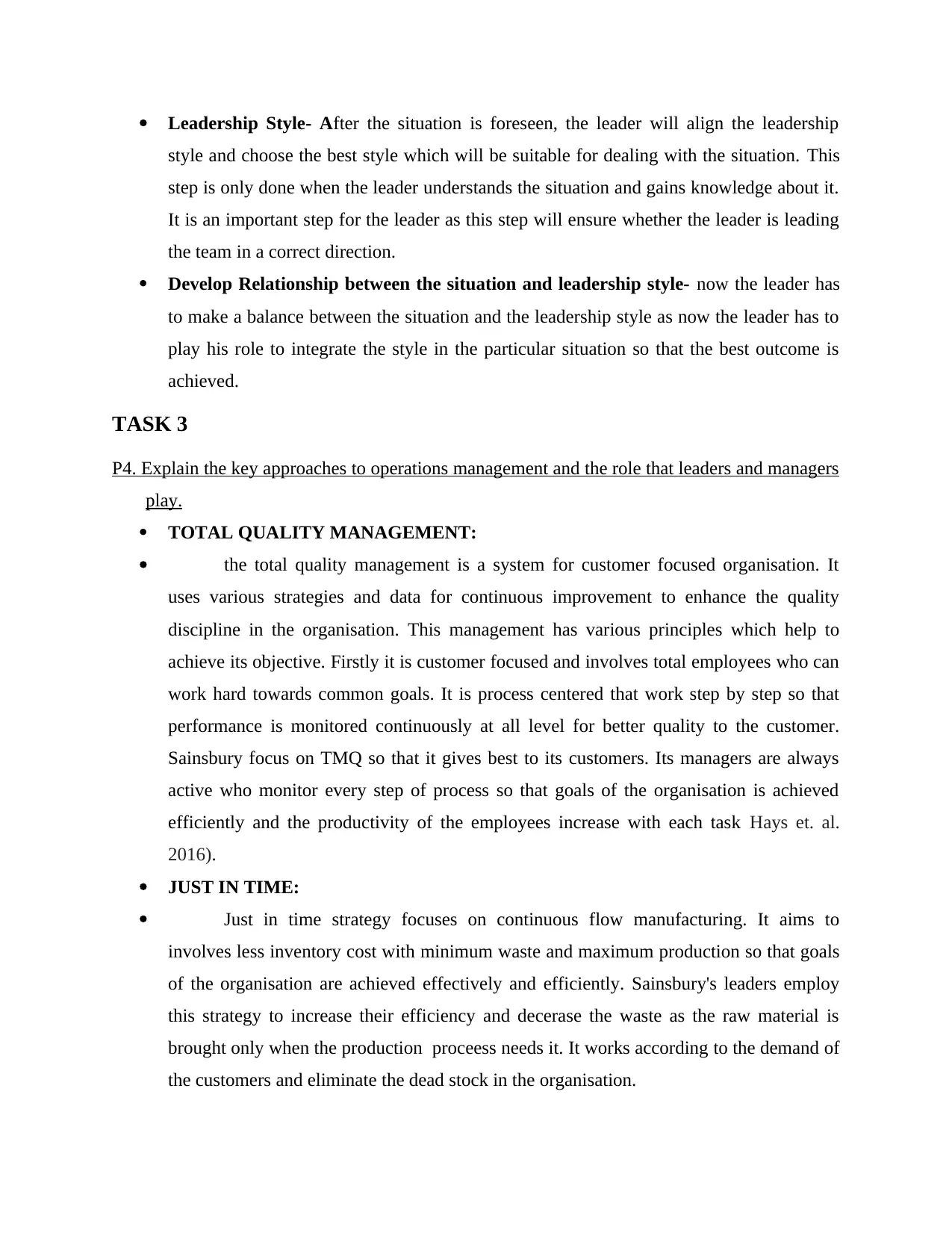
Leadership Style- After the situation is foreseen, the leader will align the leadership
style and choose the best style which will be suitable for dealing with the situation. This
step is only done when the leader understands the situation and gains knowledge about it.
It is an important step for the leader as this step will ensure whether the leader is leading
the team in a correct direction.
Develop Relationship between the situation and leadership style- now the leader has
to make a balance between the situation and the leadership style as now the leader has to
play his role to integrate the style in the particular situation so that the best outcome is
achieved.
TASK 3
P4. Explain the key approaches to operations management and the role that leaders and managers
play.
TOTAL QUALITY MANAGEMENT:
the total quality management is a system for customer focused organisation. It
uses various strategies and data for continuous improvement to enhance the quality
discipline in the organisation. This management has various principles which help to
achieve its objective. Firstly it is customer focused and involves total employees who can
work hard towards common goals. It is process centered that work step by step so that
performance is monitored continuously at all level for better quality to the customer.
Sainsbury focus on TMQ so that it gives best to its customers. Its managers are always
active who monitor every step of process so that goals of the organisation is achieved
efficiently and the productivity of the employees increase with each task Hays et. al.
2016).
JUST IN TIME:
Just in time strategy focuses on continuous flow manufacturing. It aims to
involves less inventory cost with minimum waste and maximum production so that goals
of the organisation are achieved effectively and efficiently. Sainsbury's leaders employ
this strategy to increase their efficiency and decerase the waste as the raw material is
brought only when the production proceess needs it. It works according to the demand of
the customers and eliminate the dead stock in the organisation.
style and choose the best style which will be suitable for dealing with the situation. This
step is only done when the leader understands the situation and gains knowledge about it.
It is an important step for the leader as this step will ensure whether the leader is leading
the team in a correct direction.
Develop Relationship between the situation and leadership style- now the leader has
to make a balance between the situation and the leadership style as now the leader has to
play his role to integrate the style in the particular situation so that the best outcome is
achieved.
TASK 3
P4. Explain the key approaches to operations management and the role that leaders and managers
play.
TOTAL QUALITY MANAGEMENT:
the total quality management is a system for customer focused organisation. It
uses various strategies and data for continuous improvement to enhance the quality
discipline in the organisation. This management has various principles which help to
achieve its objective. Firstly it is customer focused and involves total employees who can
work hard towards common goals. It is process centered that work step by step so that
performance is monitored continuously at all level for better quality to the customer.
Sainsbury focus on TMQ so that it gives best to its customers. Its managers are always
active who monitor every step of process so that goals of the organisation is achieved
efficiently and the productivity of the employees increase with each task Hays et. al.
2016).
JUST IN TIME:
Just in time strategy focuses on continuous flow manufacturing. It aims to
involves less inventory cost with minimum waste and maximum production so that goals
of the organisation are achieved effectively and efficiently. Sainsbury's leaders employ
this strategy to increase their efficiency and decerase the waste as the raw material is
brought only when the production proceess needs it. It works according to the demand of
the customers and eliminate the dead stock in the organisation.
⊘ This is a preview!⊘
Do you want full access?
Subscribe today to unlock all pages.

Trusted by 1+ million students worldwide
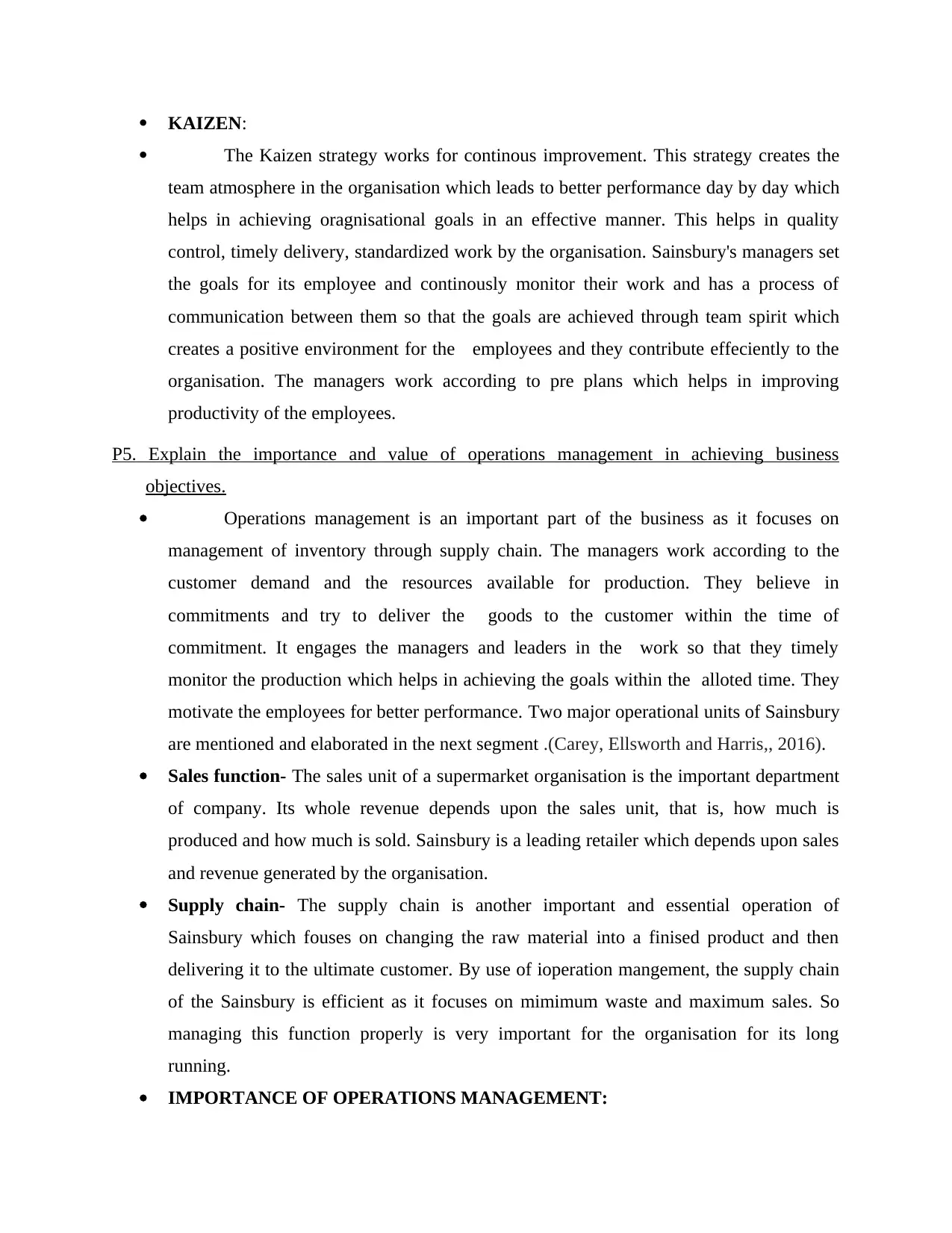
KAIZEN:
The Kaizen strategy works for continous improvement. This strategy creates the
team atmosphere in the organisation which leads to better performance day by day which
helps in achieving oragnisational goals in an effective manner. This helps in quality
control, timely delivery, standardized work by the organisation. Sainsbury's managers set
the goals for its employee and continously monitor their work and has a process of
communication between them so that the goals are achieved through team spirit which
creates a positive environment for the employees and they contribute effeciently to the
organisation. The managers work according to pre plans which helps in improving
productivity of the employees.
P5. Explain the importance and value of operations management in achieving business
objectives.
Operations management is an important part of the business as it focuses on
management of inventory through supply chain. The managers work according to the
customer demand and the resources available for production. They believe in
commitments and try to deliver the goods to the customer within the time of
commitment. It engages the managers and leaders in the work so that they timely
monitor the production which helps in achieving the goals within the alloted time. They
motivate the employees for better performance. Two major operational units of Sainsbury
are mentioned and elaborated in the next segment .(Carey, Ellsworth and Harris,, 2016).
Sales function- The sales unit of a supermarket organisation is the important department
of company. Its whole revenue depends upon the sales unit, that is, how much is
produced and how much is sold. Sainsbury is a leading retailer which depends upon sales
and revenue generated by the organisation.
Supply chain- The supply chain is another important and essential operation of
Sainsbury which fouses on changing the raw material into a finised product and then
delivering it to the ultimate customer. By use of ioperation mangement, the supply chain
of the Sainsbury is efficient as it focuses on mimimum waste and maximum sales. So
managing this function properly is very important for the organisation for its long
running.
IMPORTANCE OF OPERATIONS MANAGEMENT:
The Kaizen strategy works for continous improvement. This strategy creates the
team atmosphere in the organisation which leads to better performance day by day which
helps in achieving oragnisational goals in an effective manner. This helps in quality
control, timely delivery, standardized work by the organisation. Sainsbury's managers set
the goals for its employee and continously monitor their work and has a process of
communication between them so that the goals are achieved through team spirit which
creates a positive environment for the employees and they contribute effeciently to the
organisation. The managers work according to pre plans which helps in improving
productivity of the employees.
P5. Explain the importance and value of operations management in achieving business
objectives.
Operations management is an important part of the business as it focuses on
management of inventory through supply chain. The managers work according to the
customer demand and the resources available for production. They believe in
commitments and try to deliver the goods to the customer within the time of
commitment. It engages the managers and leaders in the work so that they timely
monitor the production which helps in achieving the goals within the alloted time. They
motivate the employees for better performance. Two major operational units of Sainsbury
are mentioned and elaborated in the next segment .(Carey, Ellsworth and Harris,, 2016).
Sales function- The sales unit of a supermarket organisation is the important department
of company. Its whole revenue depends upon the sales unit, that is, how much is
produced and how much is sold. Sainsbury is a leading retailer which depends upon sales
and revenue generated by the organisation.
Supply chain- The supply chain is another important and essential operation of
Sainsbury which fouses on changing the raw material into a finised product and then
delivering it to the ultimate customer. By use of ioperation mangement, the supply chain
of the Sainsbury is efficient as it focuses on mimimum waste and maximum sales. So
managing this function properly is very important for the organisation for its long
running.
IMPORTANCE OF OPERATIONS MANAGEMENT:
Paraphrase This Document
Need a fresh take? Get an instant paraphrase of this document with our AI Paraphraser
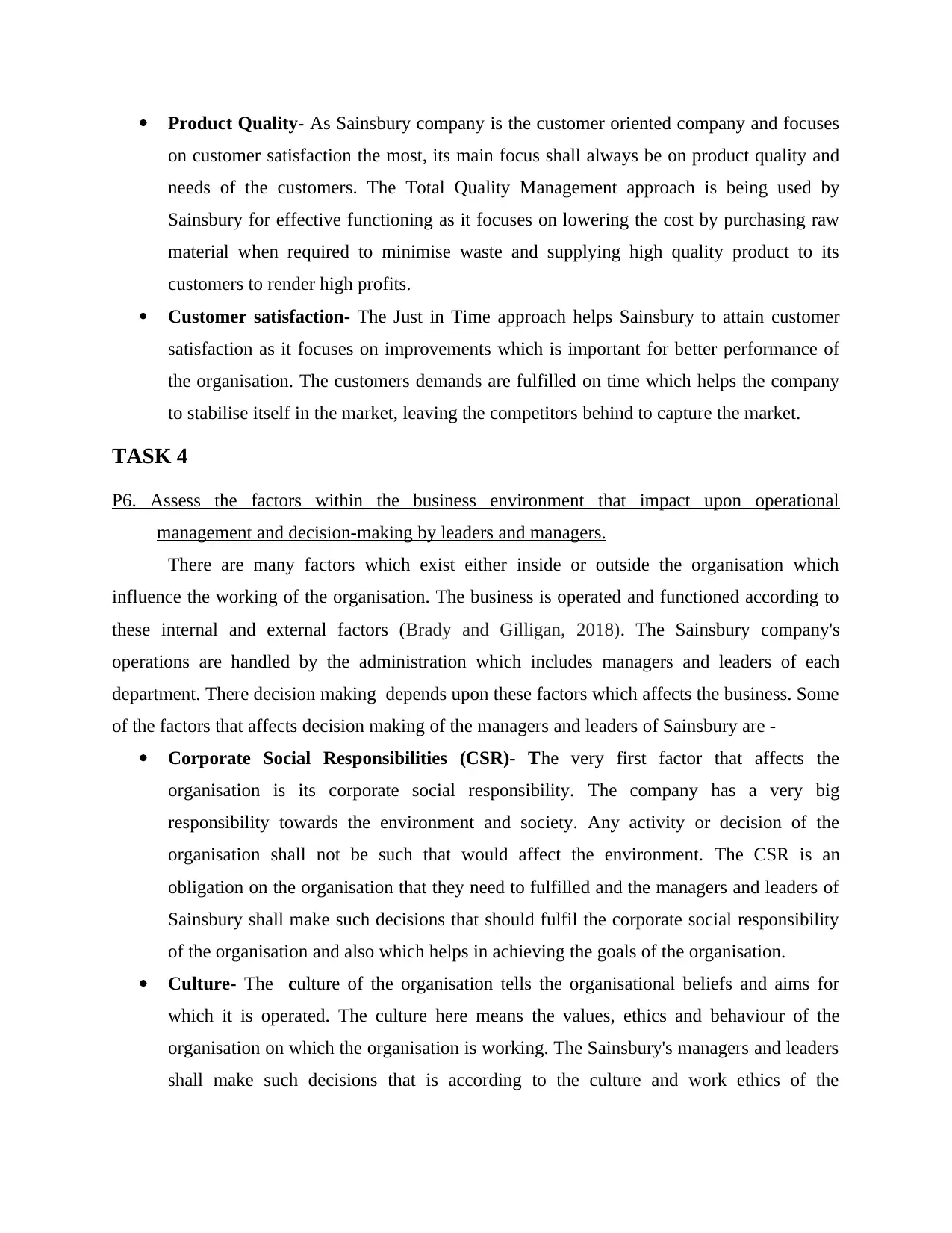
Product Quality- As Sainsbury company is the customer oriented company and focuses
on customer satisfaction the most, its main focus shall always be on product quality and
needs of the customers. The Total Quality Management approach is being used by
Sainsbury for effective functioning as it focuses on lowering the cost by purchasing raw
material when required to minimise waste and supplying high quality product to its
customers to render high profits.
Customer satisfaction- The Just in Time approach helps Sainsbury to attain customer
satisfaction as it focuses on improvements which is important for better performance of
the organisation. The customers demands are fulfilled on time which helps the company
to stabilise itself in the market, leaving the competitors behind to capture the market.
TASK 4
P6. Assess the factors within the business environment that impact upon operational
management and decision-making by leaders and managers.
There are many factors which exist either inside or outside the organisation which
influence the working of the organisation. The business is operated and functioned according to
these internal and external factors (Brady and Gilligan, 2018). The Sainsbury company's
operations are handled by the administration which includes managers and leaders of each
department. There decision making depends upon these factors which affects the business. Some
of the factors that affects decision making of the managers and leaders of Sainsbury are -
Corporate Social Responsibilities (CSR)- The very first factor that affects the
organisation is its corporate social responsibility. The company has a very big
responsibility towards the environment and society. Any activity or decision of the
organisation shall not be such that would affect the environment. The CSR is an
obligation on the organisation that they need to fulfilled and the managers and leaders of
Sainsbury shall make such decisions that should fulfil the corporate social responsibility
of the organisation and also which helps in achieving the goals of the organisation.
Culture- The culture of the organisation tells the organisational beliefs and aims for
which it is operated. The culture here means the values, ethics and behaviour of the
organisation on which the organisation is working. The Sainsbury's managers and leaders
shall make such decisions that is according to the culture and work ethics of the
on customer satisfaction the most, its main focus shall always be on product quality and
needs of the customers. The Total Quality Management approach is being used by
Sainsbury for effective functioning as it focuses on lowering the cost by purchasing raw
material when required to minimise waste and supplying high quality product to its
customers to render high profits.
Customer satisfaction- The Just in Time approach helps Sainsbury to attain customer
satisfaction as it focuses on improvements which is important for better performance of
the organisation. The customers demands are fulfilled on time which helps the company
to stabilise itself in the market, leaving the competitors behind to capture the market.
TASK 4
P6. Assess the factors within the business environment that impact upon operational
management and decision-making by leaders and managers.
There are many factors which exist either inside or outside the organisation which
influence the working of the organisation. The business is operated and functioned according to
these internal and external factors (Brady and Gilligan, 2018). The Sainsbury company's
operations are handled by the administration which includes managers and leaders of each
department. There decision making depends upon these factors which affects the business. Some
of the factors that affects decision making of the managers and leaders of Sainsbury are -
Corporate Social Responsibilities (CSR)- The very first factor that affects the
organisation is its corporate social responsibility. The company has a very big
responsibility towards the environment and society. Any activity or decision of the
organisation shall not be such that would affect the environment. The CSR is an
obligation on the organisation that they need to fulfilled and the managers and leaders of
Sainsbury shall make such decisions that should fulfil the corporate social responsibility
of the organisation and also which helps in achieving the goals of the organisation.
Culture- The culture of the organisation tells the organisational beliefs and aims for
which it is operated. The culture here means the values, ethics and behaviour of the
organisation on which the organisation is working. The Sainsbury's managers and leaders
shall make such decisions that is according to the culture and work ethics of the
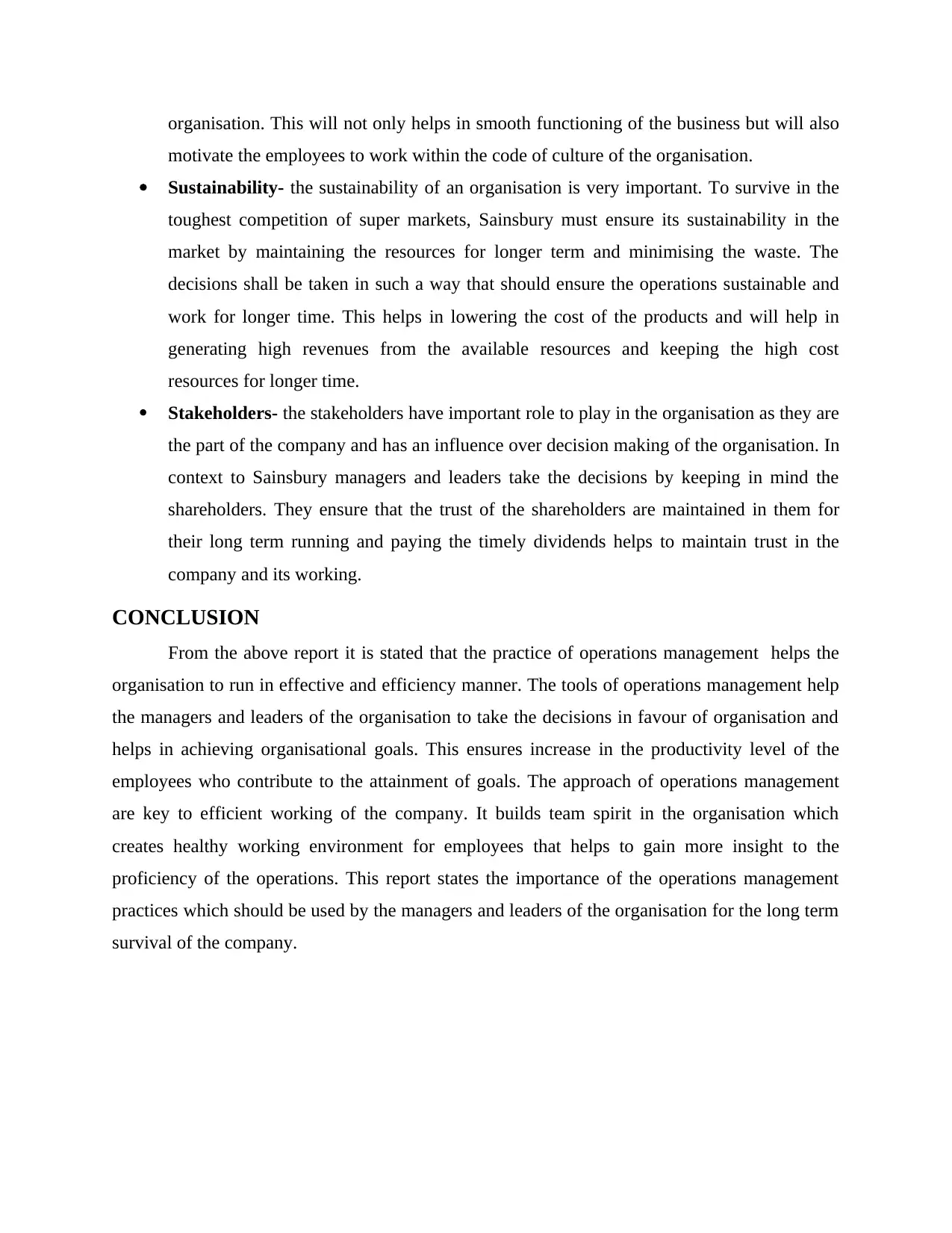
organisation. This will not only helps in smooth functioning of the business but will also
motivate the employees to work within the code of culture of the organisation.
Sustainability- the sustainability of an organisation is very important. To survive in the
toughest competition of super markets, Sainsbury must ensure its sustainability in the
market by maintaining the resources for longer term and minimising the waste. The
decisions shall be taken in such a way that should ensure the operations sustainable and
work for longer time. This helps in lowering the cost of the products and will help in
generating high revenues from the available resources and keeping the high cost
resources for longer time.
Stakeholders- the stakeholders have important role to play in the organisation as they are
the part of the company and has an influence over decision making of the organisation. In
context to Sainsbury managers and leaders take the decisions by keeping in mind the
shareholders. They ensure that the trust of the shareholders are maintained in them for
their long term running and paying the timely dividends helps to maintain trust in the
company and its working.
CONCLUSION
From the above report it is stated that the practice of operations management helps the
organisation to run in effective and efficiency manner. The tools of operations management help
the managers and leaders of the organisation to take the decisions in favour of organisation and
helps in achieving organisational goals. This ensures increase in the productivity level of the
employees who contribute to the attainment of goals. The approach of operations management
are key to efficient working of the company. It builds team spirit in the organisation which
creates healthy working environment for employees that helps to gain more insight to the
proficiency of the operations. This report states the importance of the operations management
practices which should be used by the managers and leaders of the organisation for the long term
survival of the company.
motivate the employees to work within the code of culture of the organisation.
Sustainability- the sustainability of an organisation is very important. To survive in the
toughest competition of super markets, Sainsbury must ensure its sustainability in the
market by maintaining the resources for longer term and minimising the waste. The
decisions shall be taken in such a way that should ensure the operations sustainable and
work for longer time. This helps in lowering the cost of the products and will help in
generating high revenues from the available resources and keeping the high cost
resources for longer time.
Stakeholders- the stakeholders have important role to play in the organisation as they are
the part of the company and has an influence over decision making of the organisation. In
context to Sainsbury managers and leaders take the decisions by keeping in mind the
shareholders. They ensure that the trust of the shareholders are maintained in them for
their long term running and paying the timely dividends helps to maintain trust in the
company and its working.
CONCLUSION
From the above report it is stated that the practice of operations management helps the
organisation to run in effective and efficiency manner. The tools of operations management help
the managers and leaders of the organisation to take the decisions in favour of organisation and
helps in achieving organisational goals. This ensures increase in the productivity level of the
employees who contribute to the attainment of goals. The approach of operations management
are key to efficient working of the company. It builds team spirit in the organisation which
creates healthy working environment for employees that helps to gain more insight to the
proficiency of the operations. This report states the importance of the operations management
practices which should be used by the managers and leaders of the organisation for the long term
survival of the company.
⊘ This is a preview!⊘
Do you want full access?
Subscribe today to unlock all pages.

Trusted by 1+ million students worldwide
1 out of 14
Related Documents
Your All-in-One AI-Powered Toolkit for Academic Success.
+13062052269
info@desklib.com
Available 24*7 on WhatsApp / Email
![[object Object]](/_next/static/media/star-bottom.7253800d.svg)
Unlock your academic potential
Copyright © 2020–2025 A2Z Services. All Rights Reserved. Developed and managed by ZUCOL.




